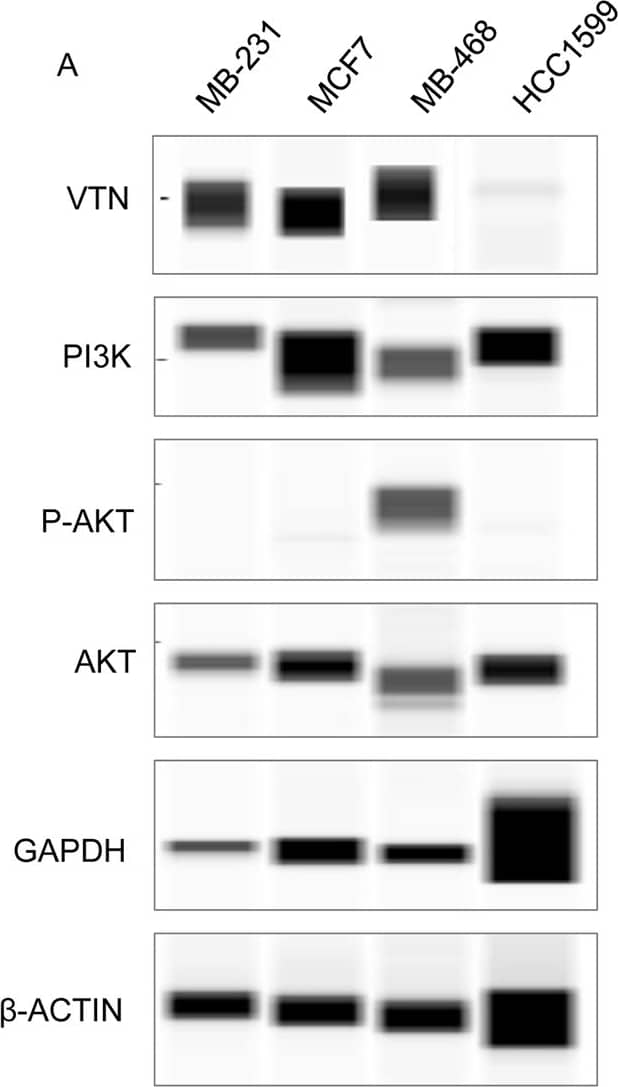Human Vitronectin Antibody Summary
Applications
Please Note: Optimal dilutions should be determined by each laboratory for each application. General Protocols are available in the Technical Information section on our website.
Scientific Data
 View Larger
View Larger
Detection of Human Vitronectin by Western Blot. Western blot shows human serum. PVDF membrane was probed with 0.1 µg/mL of Mouse Anti-Human Vitronectin Monoclonal Antibody (Catalog # MAB2349) followed by HRP-conjugated Anti-Mouse IgG Secondary Antibody (Catalog # HAF007). A specific band was detected for Vitronectin at approximately 65 kDa (as indicated). This experiment was conducted under reducing conditions and using Immunoblot Buffer Group 1.
 View Larger
View Larger
Vitronectin in Human Bladder. Vitronectin was detected in immersion fixed paraffin-embedded sections of human bladder using Mouse Anti-Human Vitronectin Monoclonal Antibody (Catalog # MAB2349) at 8 µg/mL overnight at 4 °C. Tissue was stained using the Anti-Mouse HRP-DAB Cell & Tissue Staining Kit (brown; Catalog # CTS002) and counterstained with hematoxylin (blue). Specific labeling was localized to endothelial cells. View our protocol for Chromogenic IHC Staining of Paraffin-embedded Tissue Sections.
 View Larger
View Larger
Detection of Human Vitronectin by Simple WesternTM. Simple Western lane view shows human serum, loaded at 0.2 mg/mL. A specific band was detected for Vitronectin at approximately 85 kDa (as indicated) using 5 µg/mL of Mouse Anti-Human Vitronectin Monoclonal Antibody (Catalog # MAB2349). This experiment was conducted under reducing conditions and using the 12-230 kDa separation system.
 View Larger
View Larger
Detection of Human Vitronectin by Western Blot Vitronectin expression is modulated by PI3K/AKT axis.A. Displays the pseudo blot extracted from Simple Western experiments. There are four cell-lines- MDA-MB-231, MCF7, MDA-MB-468, HCC1599, were used to evaluate the signaling cascade relationship. Different protein expression levels were normalized with an averaged house-keeping GAPDH and beta -actin expression B. Compares vitronectin concentration levels in four BC cell lines. C. PI3K concentration levels in BC same cell-lines. D. compares AKT concentration and, E. P-AKT concentration levels in the same four BC cell lines. Image collected and cropped by CiteAb from the following open publication (https://pubmed.ncbi.nlm.nih.gov/33211735), licensed under a CC-BY license. Not internally tested by R&D Systems.
Reconstitution Calculator
Preparation and Storage
- 12 months from date of receipt, -20 to -70 °C as supplied.
- 1 month, 2 to 8 °C under sterile conditions after reconstitution.
- 6 months, -20 to -70 °C under sterile conditions after reconstitution.
Background: Vitronectin
Vitronectin is a 71 kDa secreted glycoprotein produced by the liver and tumor cells. In blood, Vitronectin is called serum spreading factor. In the extracellular matrix, its function is determined by binding partners such as PAI-1, complement factors, integrins (notably alpha v beta 3) and thrombin. The 459 aa mature human Vitronectin shows 74% amino acid identity with mouse Vitronectin and contains somatomedin B-like and hemopexin-like domains, an RGD motif, a basic heparin-binding domain and sulfated tyrosines. Unbound Vitronectin is a monomer that may be cleaved to form a dimer of 65 kDa and 10 kDa components.
Product Datasheets
Citations for Human Vitronectin Antibody
R&D Systems personnel manually curate a database that contains references using R&D Systems products. The data collected includes not only links to publications in PubMed, but also provides information about sample types, species, and experimental conditions.
2
Citations: Showing 1 - 2
Filter your results:
Filter by:
-
Proteomics of Primary Uveal Melanoma: Insights into Metastasis and Protein Biomarkers
Authors: GF Jang, JS Crabb, B Hu, B Willard, H Kalirai, AD Singh, SE Coupland, JW Crabb
Cancers, 2021-07-14;13(14):.
Species: Human
Sample Types: Tissue Homogenates
Applications: Western Blot -
CRISPR/Cas9n-Mediated Deletion of the Snail 1Gene (SNAI1) Reveals Its Role in Regulating Cell Morphology, Cell-Cell Interactions, and Gene Expression in Ovarian Cancer (RMG-1) Cells.
Authors: Haraguchi M, Sato M, Ozawa M
PLoS ONE, 2015-07-10;10(7):e0132260.
Species: Human
Sample Types: Cell Lysates
Applications: Western Blot
FAQs
No product specific FAQs exist for this product, however you may
View all Antibody FAQsReviews for Human Vitronectin Antibody
Average Rating: 4.5 (Based on 2 Reviews)
Have you used Human Vitronectin Antibody?
Submit a review and receive an Amazon gift card.
$25/€18/£15/$25CAN/¥75 Yuan/¥2500 Yen for a review with an image
$10/€7/£6/$10 CAD/¥70 Yuan/¥1110 Yen for a review without an image
Filter by:
Paired with AF2349


